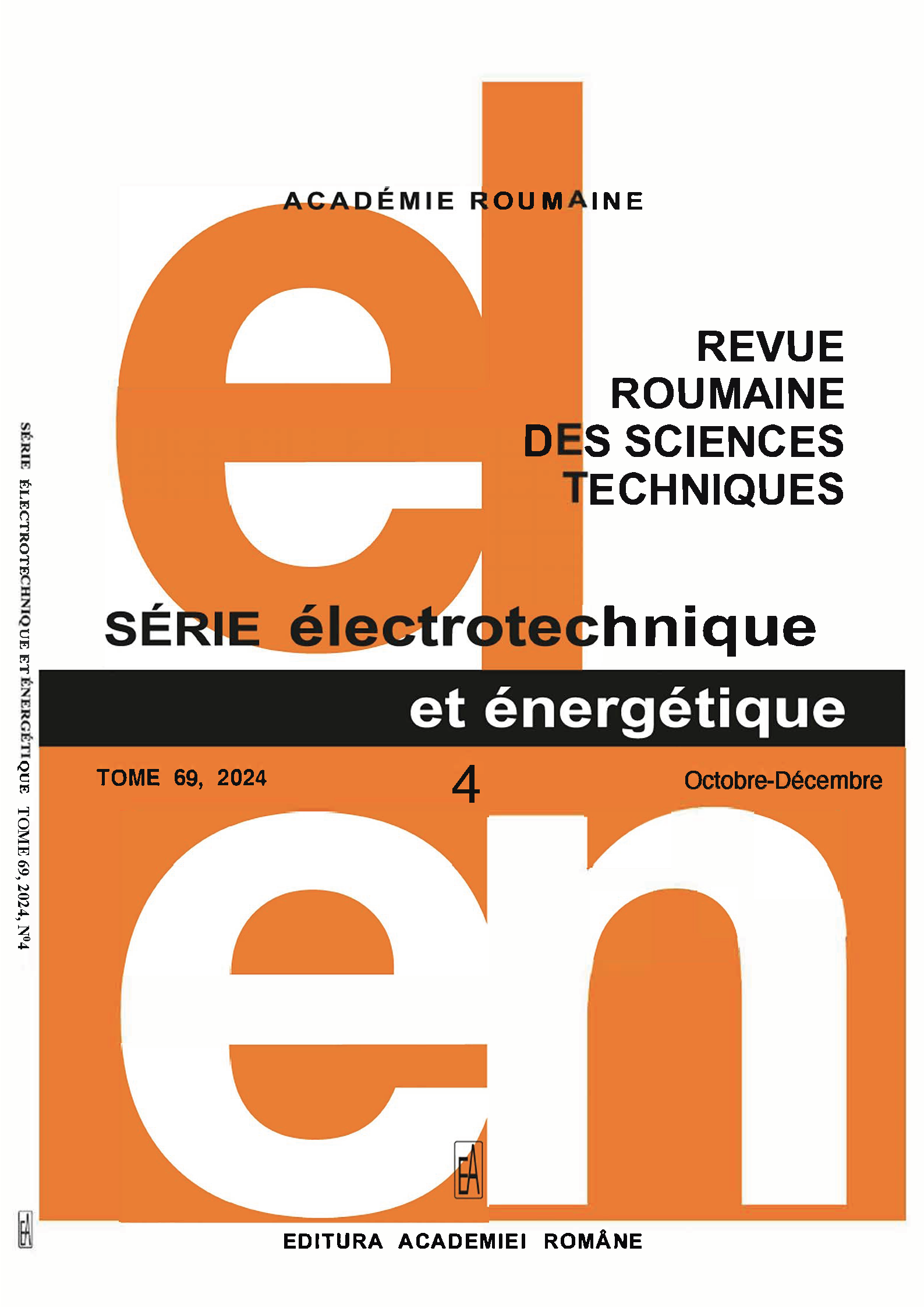CHAOTIC RANDOMIZED SPACE VECTOR PULSE WIDTH MODULATION INTENDED FOR INDUCTION MOTOR DRIVES IN INDUSTRIAL APPLICATIONS
SVPWM for Industrial Motor Drives
DOI:
https://doi.org/10.59277/RRST-EE.2024.69.4.6Keywords:
Total harmonic distortion induction drives, Random pulse generation, Harmonic spread factor, Chaotic random space vector pulse width modulationAbstract
In this industrial era, induction motor control plays a vital role, especially in speed control. Adjustment of speed is essential in all control strategies from the application perspective. There are different pulse width modulation methodologies to tune the speed and reduce harmonics. Among various pulse width modulation (PWM) strategies, space vector PWM (SVPWM) proves best for harmonic reduction in drive applications of variable frequency. SVPWM topology is modified by incorporating some randomness, generating switching pulses for the inverter, thereby controlling induction motor drives. A chaotic-based randomized algorithm is synthesized in primitive SVPWM and termed chaotic random SVPWM (CRSVPWM). It is proved from the results that the efficiency and performance are higher for chaotic randomized SVPWM induction drives than all conventional methods of PWM, having higher harmonics, lower modulation index, and less flexibility. CRSVPWM shows the advantages of better fundamental output voltage, more straightforward digital realization, improved harmonic performance, and extreme simplicity in vector selection. It is simulated through MATLAB 2021R, and hardware-based experimental validation was done using the Vivado design suite environment with Spartans-6 FPGA (XC6SLX9-2tqg144).
References
(1) E.A.R. Engku Ariff, O. Dordevic, M. Jones, A space vector PWM technique for a three-level symmetrical six-phase drive, IEEE Trans. Ind. Electron., 64, 11, pp. 8396–8405, (2017).
(2) Y. Wang, H. Ge, H. Yin et al., Improved SVPWM modulation method for three-phase dual-input dual-buck inverters, J. Power Electron., 23, 736–745 (2023).
(3) H.G. Tahere Fadaeian, S. Asghar Gholamian, A novel discontinuous pulse width modulation strategy based on circuit-level decoupling concept for Vienna rectifier, Rev. Roum. Des Sci. Tech. Série Électrotechnique Énergétique. 65, 1–2, pp. 87–95 (2020).
(4) M.A. Hannan, J.A. Ali, A. Mohamed, M.N. Uddin, A random forest regression-based space vector PWM inverter controller for the induction motor drive, IEEE Trans. Ind. Electron., 64, 4, pp. 2689–2699, (2017).
(5) E. Benyoussef, E. Barkat, direct torque control based on space vector modulation with balancing strategy of dual star induction motor, Rev. Roum. Sci. Techn. – Électrotechn. Et Énerg., 67, 1, pp. 15–20 (2022).
(6) K. Lee, G. Shen, W. Yao, Z. Lu, Performance characterization of random pulse width modulation algorithms in industrial and commercial adjustable speed drives, Applied Power Electronics Conference and Exposition (APEC), IEEE (2016).
(7) S.K. Mondal, B.K. Bose, V. Oleschuk, J.O.P. Pinto, Space vector pulse width modulation of three-level inverter extending operation into overmodulation region, IEEE Trans. Power Electron., 18, 2, pp. 604–611, (2003).
(8) S. Lakhimsetty, N. Surulivel, Somasekhar, Improvised SVPWM strategies for an enhanced performance for a four-level open-end winding induction motor drive, IEEE Trans. Ind. Electron,. 64, 4, pp. 2750–2759, (2017).
(9) Y. Huang, Y. Xu, W. Zhang, J. Zou, Hybrid RPWM technique based on modified SVPWM to reduce the PWM acoustic noise, IEEE Trans. Power Electron., 34, 6, pp. 5667–5674, (2019).
(10) S. Nageswari, V. Suresh Kumar, Field programmable gate array implementation of variable common mode injection PWM for three-level inverters, Comput. Electr. Eng., 40, 4, pp. 1238–1252, (2014).
(11) L. Chengwu, Z. Xiaomin, J. Qiguang, Research on SVPWM inverter output control technology, Fifth International Conference on Measuring Technology and Mechatronics Automation, IEEE (2013).
(12) H. Chen, Y. He, J. Liu, X. Chen, H. Xiao, W. Zhi, R. Cheng, A novel hybrid SVPWM modulation algorithm for five level active neutral-point-clamped converter, Applied Power Electronics Conference and Exposition (APEC), IEEE (2019).
(13) G. Sun, G. Yang, J. Su, M. Wang, A hybrid random SVPWM method with full modulation ratio of five phase VSI, International Power Electronics and Application Conference and Exposition (PEAC), IEEE (2018).
(14) A. Janabi, B. Wang, Hybrid SVPWM scheme to minimize the common-mode voltage frequency and amplitude in voltage source inverter drives. IEEE Trans. Power Electron. 34, 2, pp. 1595–1610 (2019).
(15) S. Singh, S. Sonar, A new SVPWM technique to reduce the inductor current ripple of three-phase Z -source inverter, IEEE Trans. Ind. Electron. 67, 5, pp. 3540–3550, (2020).
(16) A. Boudouda, Power spectral density of dual randomized discontinuous pulse width modulation, Rev. Roum. Sci. Techn. – Électrotechn. Et Énerg.. 68, 2, pp.132–138, (2023).
(17) M. Paramasivan et al., An alternative level enhanced switching angle modulation schemes for Cascaded H Bridge multilevel inverters, IEEE Access, 11, pp. 57365-57382, 2023
(18) M.G. Neacşu, S.Ş. Matei, V.Ş. Stanciu, C.Nicolescu, I. Neacşu, Reaction wheel control based on field programmable gate array technolog Rev. Roum. Sci. Techn. – Électrotechn. Et Énerg.., 63, 4, pp.379-384, (2018).
Downloads
Published
Issue
Section
License
Copyright (c) 2024 REVUE ROUMAINE DES SCIENCES TECHNIQUES — SÉRIE ÉLECTROTECHNIQUE ET ÉNERGÉTIQUE

This work is licensed under a Creative Commons Attribution-NonCommercial-NoDerivatives 4.0 International License.


